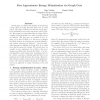Free Online Productivity Tools
i2Speak
i2Symbol
i2OCR
iTex2Img
iWeb2Print
iWeb2Shot
i2Type
iPdf2Split
iPdf2Merge
i2Bopomofo
i2Arabic
i2Style
i2Image
i2PDF
iLatex2Rtf
Sci2ools
ICCV
1999
IEEE
1999
IEEE
Fast Approximate Energy Minimization via Graph Cuts
In this paper we address the problem of minimizing a large class of energy functions that occur in early vision. The major restriction is that the energy function's smoothness term must only involve pairs of pixels. We propose two algorithms that use graph cuts to compute a local minimum even when very large moves are allowed. The first move we consider is an -swap: for a pair of labels , , this move exchanges the labels between an arbitrary set of pixels labeled and another arbitrary set labeled . Our first algorithm generates a labeling such that there is no swap move that decreases the energy. The second move we consider is an -expansion: for a label , this move assigns an arbitrary set of pixels the label . Our second algorithm, which requires the smoothness term to be a metric, generates a labeling such that there is no expansion move that decreases the energy. Moreover, this solution is within a known factor of the global minimum. We experimentally demonstrate the effective...
Arbitrary Set | Computer Vision | Energy Minimization | ICCV 1999 | Label Fp L | Many Early Vision | Smoothness Term |
| Added | 15 Oct 2009 |
| Updated | 15 Oct 2009 |
| Type | Conference |
| Year | 1999 |
| Where | ICCV |
| Authors | Yuri Boykov, Olga Veksler, Ramin Zabih |
Comments (0)

